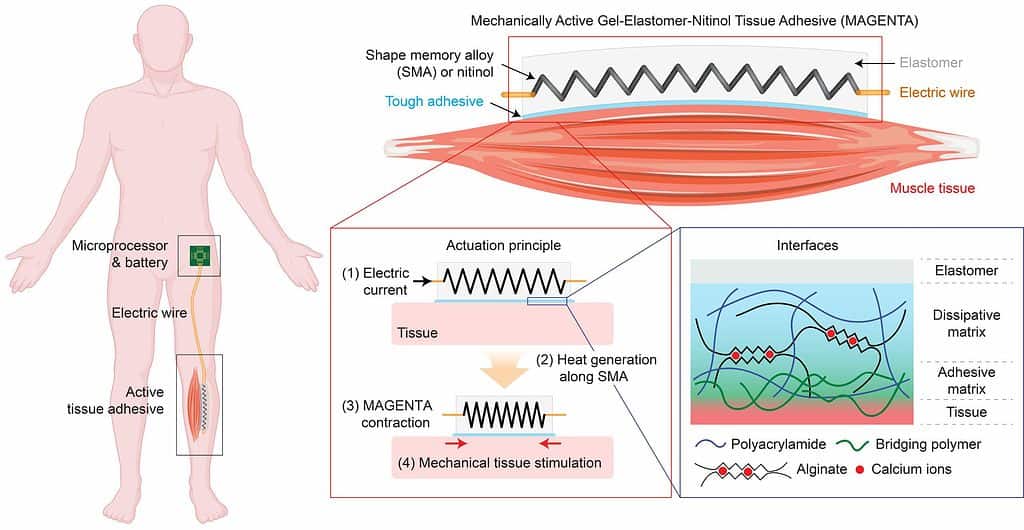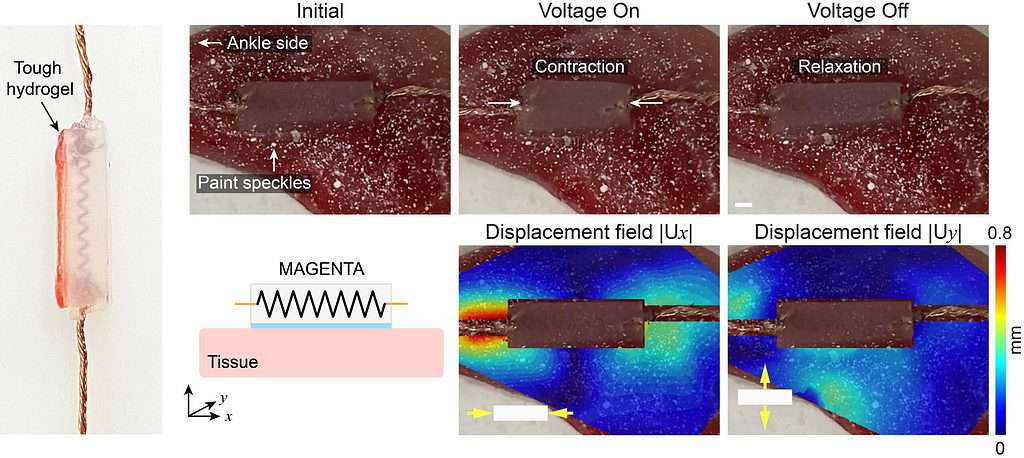
The moment the doctor opens the cast for your broken arm or leg, it feels like you’re walking on a cloud. But although it feels liberating to get rid of an uncomfortable cast that made living life on hard mode for the past weeks, you’re not done with the pain yet. All that time rendered immobilized has caused the limb’s joints to stiffen and the muscles to atrophy due to lack of activity. This is more of a nuisance for healthy people who can recover relatively quickly with physical therapy, but for patients with chronic neurological diseases that affect motor function, such as amyotrophic lateral sclerosis (ALS) and multiple sclerosis (MS), muscle wasting can be a huge problem.
To counter muscle wasting, researchers at Harvard’s Wyss Institute have developed a programmable mechanically active adhesive that stretches and contracts muscles, mimicking the natural deformation that muscles undergo during physical activity.
Saving those precious gains

The device, known as MAGENTA (mechanically active gel–elastomer–nitinol tissue adhesive), consists of a spring made from nitinol, a shape memory metal alloy of nickel and titanium. When nitinol is heated to a certain temperature, the spring is actuated, thereby stimulating the underlying muscle along its length. The frequency and duration of the stretching and contraction cycles of the spring are programmed using a microprocessor attached to MAGENTA using electrical wires.
These tiny ‘massaging’ actuators are attached to muscles with the help of a special superstrong adhesive, while an elastomer matrix forms the body of the device and insulates the heated shape memory metal alloy.
Researchers first tested MAGENTA ex vivo, meaning experimentation done in or on tissue in an artificial environment outside the organism, and later on one of the major calf muscles of a mouse.
During these experiments, MEGENTA caused no significant tissue damage or inflammation and caused mechanical strain of about 15% on muscles. This deformation is in the same ballpark as that seen naturally in the muscle when we exercise.
In the second leg of the study, the researchers tested MAGENTA on an in vivo model of muscle atrophy (experimenting using a whole, living organism as opposed to a partial or dead organism) using mice with one of their hind limbs encased in a tiny, mouse-sized cast. The rodents wore the cast for two weeks with MAGENTA strapped on their leg muscles — and the results were encouraging.
“While untreated muscles and muscles treated with the device but not stimulated significantly wasted away during this period, the actively stimulated muscles showed reduced muscle wasting,” said first-author and Wyss Technology Development Fellow Sungmin Nam. “Our approach could also promote the recovery of muscle mass that already had been lost over a three-week period of immobilization, and induce the activation of the major biochemical mechanotransduction pathways known to elicit protein synthesis and muscle growth.”

Previously, the same team of bioengineers developed a soft robot that performs regulated cyclical compression on acutely injured muscles, mimicking a massage therapist. This device proved to be effective at reducing inflammation and triggering the repair of muscle fibers. But in a head-to-head test with the MAGENTA device, only the latter proved effective at reducing muscle atrophy.
“There is a good chance that distinct soft robotic approaches with their unique effects on muscle tissue could open up disease or injury-specific mechano-therapeutic avenues,” said senior author and Wyss Founding Core Faculty member David Mooney.
MAGENTA can also be actuated by laser light, thereby eliminating the need for wires. In one demonstration, the researchers showed that MAGENTA deformed muscles when stimulated with laser light through the overlying skin.
This sort of mechanotherapy is extremely novel at this stage, but it could find practical applications quite fast as there’s currently no real viable option for effective therapy through artificial means. MAGENTA could, for instance, prove useful for people suffering from chronic motor diseases, but also people like athletes that want to recover faster and more effectively following an injury to their ligaments or muscle tissue.
“The growing realization that mechanotherapies can address critical unmet needs in regenerative medicine in ways that drug-based therapies simply cannot has stimulated a new area of research that connects robotic innovations with human physiology down to the level of the molecular pathways that are transducing different mechanical stimuli,” said Wyss Founding Director Donald Ingber.
The findings were reported in the journal Nature Materials.









